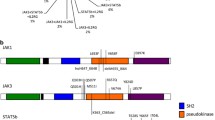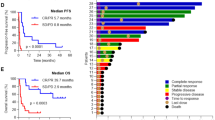Abstract
SAHA (vorinostat) is a histone deacetylase inhibitor approved by the USA Food and Drug Administration (FDA) for treating advanced refractory cutaneous T cell lymphomas. As SAHA alters the expression of many genes under control of the Sp1 transcription factor, we examined the effect of its association with the FDA-approved anticancer antibiotic Mithramycin A (MTR, plicamycin), a competitive inhibitor of Sp1 binding to DNA. Sézary syndrome (SS) cells, expanded ex vivo from peripheral blood mononuclear cells of 4 patients, were tested for their sensitivity to the drugs regarding cytotoxicity and differential responsive gene expression. Multivariate statistical methods were used to identify genes whose expression is altered by SAHA, MTR, and the synergist effect of the two drugs. MTR, like SAHA, induced the apoptosis of SS cells, while the two drugs in combination showed clear synergy or potentiation. Expression data stressed a likely important role of additive or synergistic epigenetic modifications in the combined effect of the two drugs, while direct inhibition of Sp1-dependent transcription seemed to have only limited impact. Ontological analysis of modified gene expression suggested that the two drugs, either independently or synergistically, counteracted many intertwined pro-survival pathways deregulated in SS cells, resistance of these tumors to intrinsic and extrinsic apoptosis, abnormal adhesion migration, and invasive properties, as well as immunosuppressive behavior. Our findings provide preliminary clues on the individual and combined effects of SAHA and MTR in SS cells and highlight a potential therapeutic interest of this novel pair of drugs for treatment of SS patients.





Similar content being viewed by others
Abbreviations
- SAHA:
-
Suberoylanilide hydroxamic acid
- MTR:
-
Mithramycin A
- CI:
-
Combination index
- CTCL:
-
Cutaneous T cell lymphomas
- FC:
-
Fold change
- FDR:
-
False discovery rate
- GO:
-
Gene ontology
- Sp1:
-
Specificity protein 1
- SS:
-
Sézary syndrome
References
Barba G, Matteucci C, Girolomoni G et al (2008) Comparative genomic hybridization identifies 17q11.2 approximately q12 duplication as an early event in cutaneous T-cell lymphomas. Cancer Genet Cytogenet 184:48–51. doi:10.1016/j.cancergencyto.2008.03.007
Bellei B, Pacchiarotti A, Perez M, Faraggiana T (2004) Frequent beta-catenin overexpression without exon 3 mutation in cutaneous lymphomas. Mod Pathol 17(10):1275–1281
Blume SW, Snyder RC, Ray R et al (1991) Mithramycin inhibits SP1 binding and selectively inhibits transcriptional activity of the dihydrofolate reductase gene in vitro and in vivo. J Clin Investig 88:1613–1621. doi:10.1172/JCI115474
Campbell JJ, Clark RA, Watanabe R, Kupper TS (2010) Sezary syndrome and mycosis fungoides arise from distinct T-cell subsets: a biologic rationale for their distinct clinical behaviors. Blood 116:767–771. doi:10.1182/blood-2009-11-251926
Campo E, Swerdlow SH, Harris NL et al (2011) The 2008 WHO classification of lymphoid neoplasms and beyond: evolving concepts and practical applications. Blood 117:5019–5032. doi:10.1182/blood-2011-01-293050
Capriotti E, Vonderheid EC, Thoburn CJ et al (2007) Chemokine receptor expression by leukemic T cells of cutaneous T-cell lymphoma: clinical and histopathological correlations. J Investig Dermatol 127:2882–2892. doi:10.1038/sj.jid.5700916
Chou T-C (2006) Theoretical basis, experimental design, and computerized simulation of synergism and antagonism in drug combination studies. Pharmacol Rev 58:621–681. doi:10.1124/pr.58.3.10
Contassot E, Kerl K, Roques S et al (2008) Resistance to FasL and tumor necrosis factor-related apoptosis-inducing ligand-mediated apoptosis in Sezary syndrome T-cells associated with impaired death receptor and FLICE-inhibitory protein expression. Blood 111:4780–4787. doi:10.1182/blood-2007-08-109074
Costello R, Sanchez C, Le Treut T et al (2010) Peripheral T-cell lymphoma gene expression profiling and potential therapeutic exploitations. Br J Haematol 150:21–27. doi:10.1111/j.1365-2141.2009.07977.x
Dalloul A, Laroche L, Bagot M et al (1992) Interleukin-7 is a growth factor for Sézary lymphoma cells. J Clin Investig 90:1054–1060. doi:10.1172/JCI115920
Didier G, Brézellec P, Remy E, Hénaut A (2002) GeneANOVA—gene expression analysis of variance. Bioinform Oxf Engl 18:490–491
Duvic M, Vu J (2007) Vorinostat: a new oral histone deacetylase inhibitor approved for cutaneous T-cell lymphoma. Expert Opin Investig Drugs 16:1111–1120. doi:10.1517/13543784.16.7.1111
Gardner JM, Introcaso CE, Nasta SD et al (2009) A novel regimen of vorinostat with interferon gamma for refractory Sézary syndrome. J Am Acad Dermatol 61:112–116. doi:10.1016/j.jaad.2008.11.889
Gotea V, Ovcharenko I (2008) DiRE: identifying distant regulatory elements of co-expressed genes. Nucleic Acids Res 36:W133–W139. doi:10.1093/nar/gkn300
Huang DW, Sherman BT, Lempicki RA (2009) Bioinformatics enrichment tools: paths toward the comprehensive functional analysis of large gene lists. Nucleic Acids Res 37:1–13. doi:10.1093/nar/gkn923
Huang DW, Sherman BT, Lempicki RA (2009) Systematic and integrative analysis of large gene lists using DAVID bioinformatics resources. Nat Protoc 4:44–57. doi:10.1038/nprot.2008.211
Huang L, Sowa Y, Sakai T, Pardee AB (2000) Activation of the p21WAF1/CIP1 promoter independent of p53 by the histone deacetylase inhibitor suberoylanilide hydroxamic acid (SAHA) through the Sp1 sites. Oncogene 19:5712–5719. doi:10.1038/sj.onc.1203963
Iraci N, Diolaiti D, Papa A et al (2011) A SP1/MIZ1/MYCN repression complex recruits HDAC1 at the TRKA and p75NTR promoters and affects neuroblastoma malignancy by inhibiting the cell response to NGF. Cancer Res 71:404–412. doi:10.1158/0008-5472.CAN-10-2627
Kari L, Loboda A, Nebozhyn M et al (2003) Classification and prediction of survival in patients with the leukemic phase of cutaneous T cell lymphoma. J Exp Med 197:1477–1488. doi:10.1084/jem.20021726
Krejsgaard T, Odum N, Geisler C et al (2012) Regulatory T cells and immunodeficiency in mycosis fungoides and Sézary syndrome. Leukemia 26:424–432. doi:10.1038/leu.2011.237
Kim EJ, Hess S, Richardson SK et al (2005) Immunopathogenesis and therapy of cutaneous T cell lymphoma. J Clin Investig 115:798–812. doi:10.1172/JCI24826
Kim S-N, Kim NH, Lee W et al (2009) Histone deacetylase inhibitor induction of P-glycoprotein transcription requires both histone deacetylase 1 dissociation and recruitment of CAAT/enhancer binding protein beta and pCAF to the promoter region. Mol Cancer Res 7:735–744. doi:10.1158/1541-7786.MCR-08-0296
Lee CS, Ungewickell A, Bhaduri A et al (2012) Transcriptome sequencing in Sezary syndrome identifies Sezary cell and mycosis fungoides-associated lncRNAs and novel transcripts. Blood 120:3288–3297. doi:10.1182/blood-2012-04-423061
Livak KJ, Schmittgen TD (2001) Analysis of relative gene expression data using real-time quantitative PCR and the 2(-Delta Delta C(T)) Method. Methods San Diego Calif 25:402–408. doi:10.1006/meth.2001.1262
Mir MA, Majee S, Das S, Dasgupta D (2003) Association of chromatin with anticancer antibiotics, mithramycin and chromomycin A3. Bioorg Med Chem 11:2791–2801
Nakayama A, Odajima T, Murakami H et al (2001) Characterization of two promoters that regulate alternative transcripts in the microtubule-associated protein (MAP) 1A gene. Biochim Biophys Acta 1518:260–266
Narducci MG, Scala E, Bresin A et al (2006) Skin homing of Sézary cells involves SDF-1-CXCR4 signaling and down-regulation of CD26/dipeptidylpeptidase IV. Blood 107:1108–1115. doi:10.1182/blood-2005-04-1492
Ritchie ME, Phipson B, Wu D et al (2015) limma powers differential expression analyses for RNA-sequencing and microarray studies. Nucleic Acids Res 43:e47. doi:10.1093/nar/gkv007
Rivero S, Ruiz-García A, Díaz-Guerra MJM et al (2011) Characterization of a proximal Sp1 response element in the mouse Dlk2 gene promoter. BMC Mol Biol 12:52. doi:10.1186/1471-2199-12-52
Shao Y, Gao Z, Marks PA, Jiang X (2004) Apoptotic and autophagic cell death induced by histone deacetylase inhibitors. Proc Natl Acad Sci USA 101:18030–18035. doi:10.1073/pnas.0408345102
Tajrishi MM, Shin J, Hetman M, Kumar A (2014) DNA methyltransferase 3a and mitogen-activated protein kinase signaling regulate the expression of fibroblast growth factor-inducible 14 (Fn14) during denervation-induced skeletal muscle atrophy. J Biol Chem 289:19985–19999. doi:10.1074/jbc.M114.568626
Wozniak MB, Villuendas R, Bischoff JR et al (2010) Vorinostat interferes with the signaling transduction pathway of T-cell receptor and synergizes with phosphoinositide-3 kinase inhibitors in cutaneous T-cell lymphoma. Haematologica 95:613–621. doi:10.3324/haematol.2009.013870
Wu J, Nihal M, Siddiqui J et al (2009) Low FAS/CD95 expression by CTCL correlates with reduced sensitivity to apoptosis that can be restored by FAS upregulation. J Investig Dermatol 129:1165–1173. doi:10.1038/jid.2008.30931
Zhang Q, Nowak I, Vonderheid EC et al (1996) Activation of Jak/STAT proteins involved in signal transduction pathway mediated by receptor for interleukin 2 in malignant T lymphocytes derived from cutaneous anaplastic large T-cell lymphoma and Sezary syndrome. Proc Natl Acad Sci USA 93:9148–9153
Acknowledgements
This work was supported by the Institut National de la Santé et de la Recherche Médicale (INSERM) and the French National Research Agency (ANR-08-SYSC-003 CALAMAR). We thank Ms. L. Borg for expert supervision of Marseille Luminy cell culture facilities, Dr. J. Imbert (TAGC), Dr. A. Bergon, and Mr. Nicolas Fernandez (transcriptomic and Genomic Marseille-Luminy TGML/TAGC platform) for their helpful advice for the preparation of the manuscript.
Availability of supporting data
The microarray data included in the paper have been deposited under embargo in GEO to be released upon acceptance of the paper for publication at: (http://www.ncbi.nlm.nih.gov/geo/query/acc.cgi?token=glypyyownjmtnmp&acc=GSE64119).
Author information
Authors and Affiliations
Contributions
BKP and RTC initiated the Sézary project and RTC supervised hospital collaborations. PP supplied characterized PBMC samples from SS patients. BKP conceived the experiments; BKP, BL, JG, and NB (Beaufils) designed the experiments; and BKP, BL, NB (Beaufils), NB (Bonnet), RC, and TLT carried out the experiments. PR designed the statistical analyses of microarray data and RR carried out the bioinformatic analyses. BKP carried out the interpretation of the analyses and drafted the article. PR, RR, VG, and RTC corrected the manuscript. All authors read and approved the final manuscript.
Corresponding author
Ethics declarations
Conflict of interest
All the authors have no conflicts of interest to declare.
Consent
Patients have signed written informed consent before Sézary cell collection.
Ethical approval
The study was approved by the “Comité de Protection des Personnes” (CPP) Sud-Méditerranée II (ethics committee).
Funding
All the authors have no funding to declare.
Electronic supplementary material
Below is the link to the electronic supplementary material.
Rights and permissions
About this article
Cite this article
Ragheb, R., Venton, G., Chelbi, R. et al. Vorinostat and Mithramycin A in combination therapy as an interesting strategy for the treatment of Sézary T lymphoma: a transcriptomic approach. Arch Dermatol Res 309, 611–623 (2017). https://doi.org/10.1007/s00403-017-1761-0
Received:
Revised:
Accepted:
Published:
Issue Date:
DOI: https://doi.org/10.1007/s00403-017-1761-0




